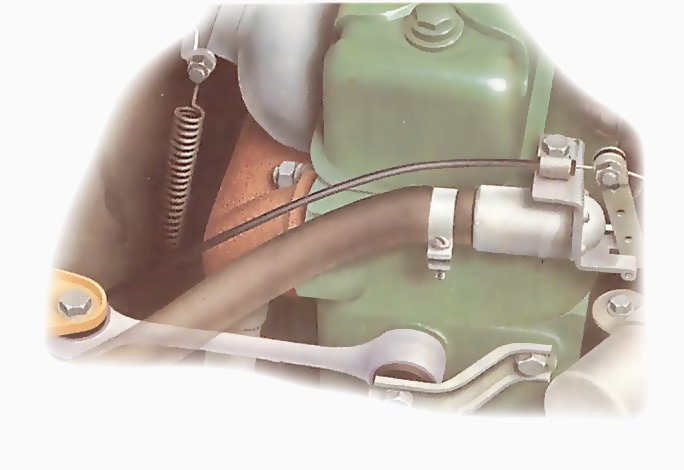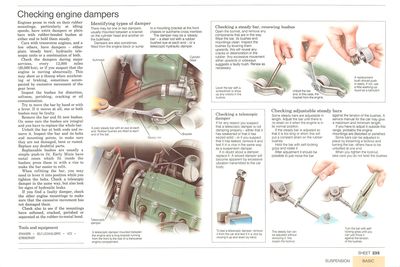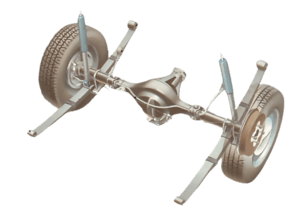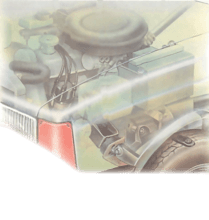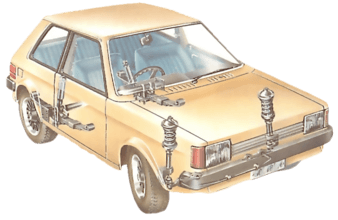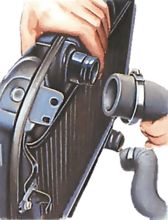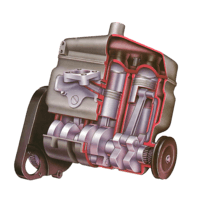Engines prone to rock on their rubber mountings, particularly at idling speeds, have extra dampers or plain bars with rubber-bonded bushes at either end to hold them steady.
Cars with transverse engines, and a few others, have dampers - either plain steady bars, hydraulic telescopic units or a combination of both.
Check the dampers during major services, every 12,000 miles (20,000 km), or if you suspect that the engine is moving abnormally. This may show as a thump when accelerating or braking, sometimes accompanied by excessive movement of the gear lever.
This video course is the best way to learn everything about cars.
Three hours of instruction available right now, and many more hours in production.
- 4K HD with full subtitles
- Complete disassembly of a sports car
Inspect the bushes for distortion, softness, perishing, cracking or oil contamination.
Try to move the bar by hand or with a lever. If it moves at all, one or both bushes may be faulty.
Remove the bar and fit new bushes. On some cars the bushes are integral and you have to replace the whole bar.
Unbolt the bar at both ends and remove it. Inspect the bar and its bolts and mounting points, to make sure they are not damaged, bent or rusted. Replace any doubtful parts.
Replaceable bushes are usually a simple push-in fit. Early Minis have metal cones which fit inside the bushes: press these in with a vice to make the bar easier to refit.
When refitting the bar, you may need to lever it into position while you tighten the bolts. Check a telescopic damper in the same way, but also look for signs of hydraulic leaks.
If you find a faulty damper, check the other engine mountings to make sure that the excessive movement has not damaged them.
Check also to see if the mountings have softened, cracked, perished or separated at the rubber-to-metal bond.
Replacing steady bar bushes
Lever the bar with a screwdriver to show up any cracks in the bushes.
Unbolt the bar and, in this case, the bracket, from the engine.
A replacement bush should push in easily; if not, use a little washing-up liquid as a lubricant.
Open the bonnet, and remove any components that are in the way. Wipe the bar, its bushes and the mountings clean. Inspect the bushes by levering them upwards, this will reveal any cracks or deterioration in the rubber. Any excessive movement either upwards or sideways suggests a faulty bush. Renew as necessary.
Checking adjustable steady bars
This steady bar can be adjusted without removing it: first loosen the locknut.
Some steady bars are adjustable in length. Adjust the bar until there is no strain on it when the engine is in its normal position.
If the steady bar is adjusted so that it is too long or short, this will put a constant strain on the rubber bushes.
Turn the bar with self-locking grips until you can just move it against the tension of the bushes.
Hold the bar with self-locking grips and rotate it.
After adjustment it should be possible to just move the bar against the tension of the bushes. A service manual for the car may give a maximum and minimum length.
If you have to adjust it outside this range, probably the engine mountings are distorted or perished.
Some bars can be adjusted in place by loosening a locknut and turning the bar; others have to be unbolted at one end.
When you tighten the locknut, take care you do not twist the bushes.
Checking a telescopic damper
To test a telescopic damper, remove it from the car and test it in a vice by moving it up and down by hand.
If for any reason you suspect that a telescopic damper is not damping properly - either that it has weakened or that it has seized solid - or if you suspect that it has leaked, remove it and test it in a vice the same way as a suspension damper.
If in doubt about a damper, replace it. A seized damper will become apparent by excessive vibration transmitted to the car body.

